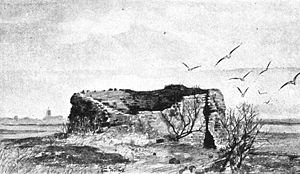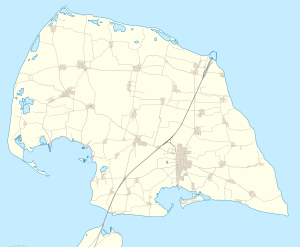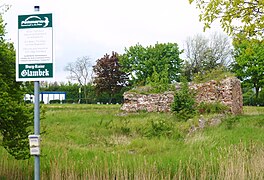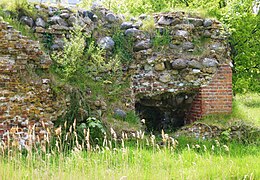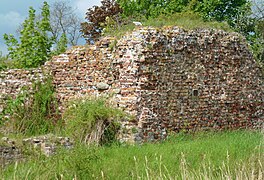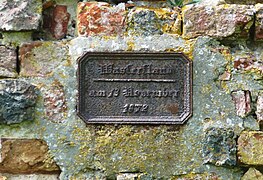Glambek Castle
| Glambek Castle | ||
|---|---|---|
|
Drawing of the castle ruins from 1895 |
||
| Alternative name (s): | Glambeck | |
| Creation time : | 1210 | |
| Castle type : | Niederungsburg | |
| Conservation status: | Bergfriedrest, wall remains, moat, wall rest | |
| Construction: | Brick | |
| Place: | Castle on Fehmarn Castle Depth | |
| Geographical location | 54 ° 24 '43.8 " N , 11 ° 12' 30" E | |
|
|
||
The Glambæk even Glambeck written is the ruins of a medieval lowland castle on the peninsula Burgtiefe in the south of Fehmarn .
It is located in the Fehmarn district of Burg auf Fehmarn . The complex, which the Danish king Waldemar II had built in 1210, was the most important setting in the island's history until it was destroyed in the Thirty Years' War .
description
The rectangular complex is 36 meters wide and 53 meters long and is surrounded by a moat and a flat wall. Of the brick buildings of the castle, only the stump of the square keep with its 11 x 11 meter foundation made of field stones in the northeast corner and remnants of the curtain wall are preserved. The walls of the keep stand up to a height of four meters and are two meters thick. There used to be an additional defense tower in the southwest corner as additional protection .
This lordly complex - besides Linau Castle - is probably the only remaining medieval stone castle in Schleswig-Holstein, at least still as a modest ruin with rising masonry, whose once numerous noble castles of the 11th to 15th centuries of the Motte type (cf. the freely reconstructed tower hill castle Lütjenburg ) were mostly made of wood on mounds of earth.
history
The eventful history of the castle is due to the contrast between the Holstein counts and the Danish kings . In 1248, during the reign of King Erik IV , the wedding of Erik's youngest brother Christoph and the Pomeranian duke's daughter Margarete Sambiria , also known as Margarete Sprenghest, took place at the castle . The castle survived the reign of Erik V from 1259 to 1286 without any conflict.
1307 came the "Glambeker comparison". The Danish King Erik VI. mediated in a conflict between the Counts of Holstein and the landed gentry.
Erik VI's brother, the Danish King Christoph II , issued the oldest Fehmarn land law in 1320 for the “ landscape ” . Jurisdiction was the Glambæk on which his bailiff from the noble Reventlow resided. He also assumed the office of judge and in 1321 left many people hanging at Glambek Castle because they had stood up for Johann II von Holstein-Kiel , who died in the same year . Johann III. von Holstein-Kiel was enfeoffed with the island of Fehmarn in 1326. He issued a more lenient jury law ( handfests ) with the simultaneous abolition of the Glambek court. This new legal source was valid until 1558.
In 1358 the Danish King Waldemar IV. Atterdag appeared with an armada in front of the castle depth. The castle became easy prey at Atterdag , who drove the Holstein graves away. However, the son of Johann III, Adolf VII of Holstein-Kiel , allied himself with the related dukes of Schleswig and Mecklenburg and recaptured the island in 1359. After a peace period of 57 years, the Danish King Erik of Pomerania conquered Fehmarn in 1416 and had the castle captain of Glambek beheaded. But the Holstein counts again conquered the island shortly afterwards.
In 1420 King Erik reappeared on the island, this time with 700 ships. It was repelled twice, but the third attempt to land was successful. He destroyed the castle, devastated the island and murdered two thirds of the population.
The Holstein Count Adolf VIII recaptured Fehmarn in 1424 and settled the island with Dithmarsch farming families. After the Counts of Holstein had once again lost the castle to their opponents, Count Adolf called the Vitalienbrüder to help them to conquer the heavily fortified Glambek in 1426 . These remained there until the facility was pledged to the city of Lübeck in the course of the Peace of Vordingborg in 1435.
When the new Fehmarn land law was presented in 1558, the governor Heinrich Rantzau was physically attacked. In the same year the bailiff complained to the sovereign about the deterioration of the facility. Glambek Castle was now used as a warehouse for wood and grain.
In 1627, 500 imperial soldiers under the Count of Jean de Merode conquered the island during the Thirty Years War . When King Christian IV tried to retake the castle in 1628, it was finally destroyed. Most of the bricks were subsequently removed until the castle sank under drifting sand. Their remains were washed away again by the flood of the Baltic Sea in 1872 , and from 1908 the ruins were systematically exposed.
gallery
swell
- Information brochure from the Fehmarn Tourist Service
literature
- Richard Haupt (edit.): The architectural and art monuments of the province of Schleswig-Holstein . Volume 2. Homann, Kiel 1888, p. 81 ( online ).
Web links
Individual evidence
- ↑ Jens Friedhoff : "Lebendiges Mittelalter" and "forgotten ruins" - the tower hill castle Lütjenburg and the castle ruins Glambeck in Schleswig-Holstein , in: Burgen und Schlösser, magazine for castle research and monument preservation, ed. from the European Castle Institute , 4/2012, pp. 215–221
- ^ Nicoletta Adams: Baltic Sea Coast, Schleswig-Holstein . DuMont Reiseverlag, Ostfildern 2005, ISBN 3-7701-6511-X , p. 45.
